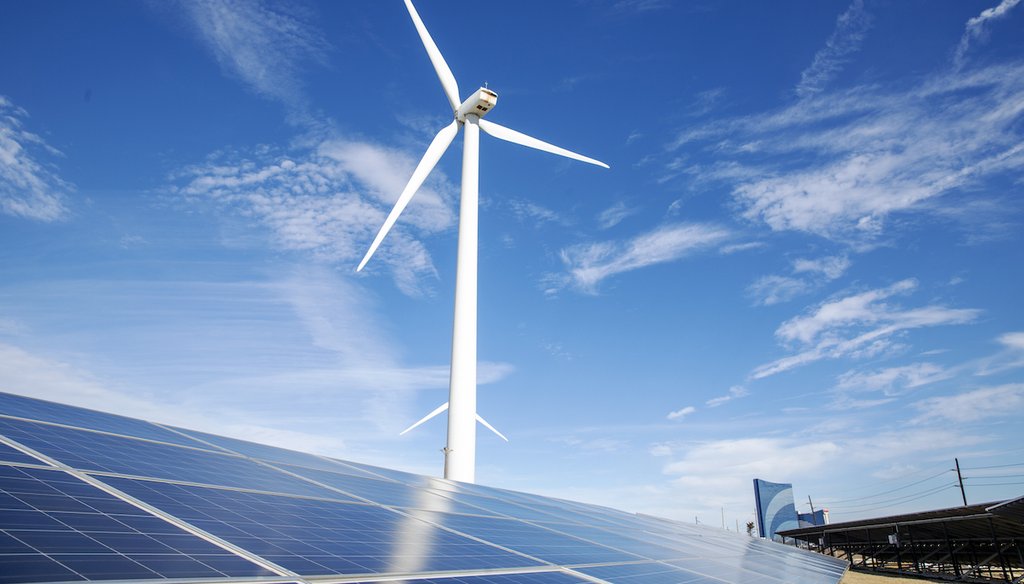Stand up for the facts!
Our only agenda is to publish the truth so you can be an informed participant in democracy.
We need your help.
I would like to contribute

Wind turbines spin to generate electricity above solar panels in Atlantic City, New Jersey, in this 2021 file photo. (AP)
If Your Time is short
-
Independent research groups say tax incentives in the recently enacted Inflation Reduction Act would expand renewable energy and reduce carbon emissions.
-
Recent growth in solar, wind and battery storage put Biden’s goals within reach.
-
Outside factors, including lower economic growth and the need to build transmission lines could slow the process of bringing renewable power online.
The Democrats’ Inflation Reduction Act, signed into law earlier this month, delivered an unprecedented $369 billion to put the nation on the path to steep reductions in greenhouse gas emissions. Central to the plan is the expansion of renewable power, and President Joe Biden put some ambitious numbers on the table.
"By 2030, we’ll have 950 million solar panels operating in the United States," he said Aug. 16. "120,000 wind turbines operating. We’ll have 2,300 battery plants to store clean energy."
The administration is banking on the bill’s tax credits for investment in solar, wind, hydrogen and other forms of clean power to drive this change.
We can’t verify predictions, but we can put Biden’s forecast up against independent estimates of what the future holds.
Three independent research groups concur that the overall plan would cut emissions to about 40% below 2005 levels, as the U.S. Department of Energy projected, and that the clean power elements would play the largest role. In that light, Biden’s numbers could become reality.
But that depends on many factors, including the pace of economic growth and practical issues, such as getting permits to build new facilities.
The clean energy portion of the Democratic bill for solar, wind and battery storage will cost more than $130 billion over 10 years. To get a sense of the potential impact of the legislation, we looked at recent trends for each type of power.
Typically, solar power is measured in megawatts. Over the past five years, solar capacity has grown an average of about 26% a year.
The U.S. currently has 200 million solar panels, according to analysts at the private energy consulting firm Rhodium Group, who based that number on the average output of a typical panel. To reach Biden’s target of 950 million solar panels by 2030 would require a nearly fivefold increase in the next eight years.
The recent rate, coupled with the law’s incentives for private investors to build solar arrays, puts Biden’s goal within reach.
"We estimate that in 2030 there will be 560 million to 1.7 billion solar panels installed at solar farms," said energy policy analyst Ben King with the Rhodium Group.
While Rhodium’s range is wide — with Biden’s number falling in the middle — some of the uncertainty is because of the solar panels themselves. Solar technology is expected to improve, meaning a panel installed in five years will generate more electricity than one installed today.
Similarly, wind turbines have also been getting more powerful. The average turbine put up in 2021 can deliver 3 MW of power. That’s predicted to rise to 4 MW in the coming years.
Today, according to the U.S. Geological Survey, the country has about 72,000 wind turbines. It added about 6,500 turbines in 2020, and 5,400 in 2021.
Biden’s goal requires an additional 50,000 windmills. Back-of-the-envelope math suggests that if the U.S. maintained the 2020 pace of expansion, in the span of eight years, it would more than hit that target. The Rhodium Group thinks 135,000 turbines is possible, and the American Clean Power Association, a trade group representing renewable energy firms, said the administration’s forecast is "on par" with industry estimates.
With battery storage, technology is changing quickly. Costs have been decreasing, while capacity has increased. Government data shows battery installations tripled in 2021, and based on projects slated to open, that pace will continue, putting the country on track to see capacity rise tenfold between 2019 and 2023.
King with Rhodium said his group forecasts the country will add between 450 to 2,900 utility-scale systems by 2030.
Biden’s goal of 2,300 is closer to the upper end of that range.
The Democratic plan fuels expansion by offering tax credits that will be in place for the next decade.
Tax credits can be potent policy tools. Whatever a company’s tax bill, a tax credit reduces it dollar for dollar. The Inflation Reduction Act gives a production tax credit that could be as much as 2.6 cents for each kilowatt-hour sold during the first 10 years of operation. There’s also an investment tax credit that could be equal to more than 30% of the project cost, if the company meets wage and domestic content requirements.
Large energy companies, including National Grid, Shell and Duke Energy, got behind the legislation.
Power industry analysts say the 10-year guaranteed tax advantages are a strong incentive.
"There’s billions of dollars of profit that are up for grabs if you are a solar developer or a utility," said Princeton engineering professor Jesse Jenkins at an Aug. 10 webinar.
King said that the impact of the new law varies by the type of energy, especially for batteries.
"We find that the Inflation Reduction Act helps drive 13-55% of more solar capacity, 25-65% more wind capacity, and 30-400% more battery capacity in 2030," King said.
Many forces could throw off all of these projections.
If the economy grows more slowly than projected, there would be less demand for power, and less need to add solar panels and wind turbines.
If the price of oil and gas falls, renewables will be less competitive.
Problems with sluggish supply chains and shortages of skilled workers might be difficult to avoid and could slow implementation
That’s at the macro level. Problems at the micro level are also likely, said Lori Bird, director of renewable energy at the World Resources Institute, a global research group focused on sustainable technology. Finding places to put new energy facilities will be one of the biggest challenges in the next decade.
"As you build more and more, you have to move to the sites that are less appealing," Bird said. "Solar can be more flexible. It can work from small to utility scale. With wind, you have to find a site where the wind is consistently strong."
A host of concerns can block the installation of any energy array, including impacts on wildlife and opposition from local residents.
Bird also warned that connecting to the local power grid is already a problem. This isn’t about the lack of transmission lines — which is another hurdle, but one that concerns moving power over long distances. It’s about getting new power into the grid in the first place. The lines for projects waiting to get plugged in are already becoming longer.
The typical wait from a company’s first request for access to the grid to full operation is now about a year and a half longer than it used to be, the Lawrence Berkeley National Laboratory found. In the first decade of the 2000s, it took 2.1 years. In the decade that followed, it rose to 3.7 years.
The bipartisan infrastructure law has billions to help with interconnection and transmission shortfalls. But analysts say that work will need to be done quickly, and in coordination with the demand created by new renewable power plants.
Our Sources
Joe Biden, tweet, Aug. 16, 2022
U.S. Energy Information Administration, Electricity data browser, July 2022
U.S. Energy Information Administration, Solar power and batteries account for 60% of planned new U.S. electric generation capacity, March 17, 2022
U.S. Energy Information Administration, Battery storage in the United States: An update on market trends, Aug. 16, 2021
U.S. Energy Information Administration, Solar photovoltaic module shipments reach record high in 2021, May 2022
U.S. Energy Information Administration, Battery systems on the U.S. power grid are increasingly used to respond to price, July 27, 2022
U.S. Geological Survey, U.S. Wind Turbine Database, accessed Aug. 19, 2022
National Renewable Energy Laboratory, Annual Technology Baseline, 2022
National Renewable Energy Laboratory, Solar Industry Update, June 22, 2021
Lawrence Berkeley National Laboratory, Utility-Scale Solar, 2021
Lawrence Berkeley National Laboratory, Characteristics of Power Plants Seeking Transmission Interconnection, April 2022
Congressional Research Service, Tax Provisions in the Inflation Reduction Act of 2022 (H.R. 5376), Aug. 10, 2022
Congressional Research Service, Proposed Tax Preference for Domestic Content in Energy Infrastructure , Aug. 5, 2022
National Law Review, Relief Arrives for Renewable Energy Industry - Inflation Reduction Act of 2022, Aug. 19, 2022
Congressional Research Service, Energy Tax Provisions: Overview and Budgetary Cost, Aug. 3, 2021
Congressional Research Service, Tax Provisions in the Inflation Reduction Act of 2022 (H.R. 5376), Aug. 10, 2022
Center for Climate and Energy Solutions, 27 companies call for Congress to refocus on Build Back Better climate provisions, Feb. 9, 2022
PolitiFact, Historic climate investments put US on track toward net-zero emissions, Aug. 12, 2022
McGuireWoods, Inflation Reduction Act Extends and Modifies Tax Credits for Wind Projects, Aug. 24, 2022
Freeing Energy, What is the average size in watts of modern solar panels, 2021
Resources for the Future, Inflation Reduction Act of 2022: Modeling Major Climate and Energy Provisions, Aug. 10, 2022
Deloitte, 2022 renewable energy industry outlook, 2021
Utility Dive, US energy storage capacity tripled in 2021: EIA, July 12, 2022
U.S. Energy Department, DOE Launches New Initiative From President Biden’s Bipartisan Infrastructure Law To Modernize National Grid, Jan. 12, 2022
U.S. Energy Department, Land-Based Wind Market Report: 2022 Edition, August 2022
Interview, Lori Bird, director, U.S. Energy and Polsky Chair for Renewable Energy, World Resources Institute, Aug. 22, 2022
Email exchange, Ben King, associate director, Energy and Climate practice, Rhodium Group, Aug. 22, 2022
Email exchange, Jay Diffendorfer, research ecologist, Geosciences and Environmental Change Science Center, U.S. Geological Survey, Aug. 22, 2022
Email exchange, Eric Lantz, group research manager, National Renewable Energy Laboratory, Aug. 24, 2022














































